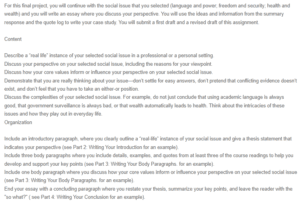Discussion – Inclusive Decision Making
How did the decision-making process in your example affect outcomes?
In the Harvard Business Review article, ‘Woke Washing, Your Company Won’t Cut It,’ several brands are not supporting the Black Lives Matter movement and ironically cause people of color to suffer even increased injustices in their workplaces. The article provides an illustration of Kelli, an African American woman, and her ordeal of injustice in her workplace.
After Kelli’s team members left the organization, her workload increased. When Kelli sought a promotion to keep up with the rising demand, her boss was too occupied to address the issue, claiming that there were more important priorities to draft an official communication design in response to the rise in racial discrimination stories making headlines (Dowell & Jackson, 2020). Ironically, the top leadership prioritizes their public image, whereas internally, they dismissed the very Black voices they argued to be concerned about. Sadly, Kelli’s employer missed the whole point and failed to see how they were executing the type of injustice they said to be against.
What Could Be Done Differently In The Future?
Organizations can achieve total inclusivity if they comprehend the cause of the inclusion gap in the first place. To acquire such knowledge, organizations need to examine the process and parties involved in decision-making. Further, the organizations can weigh the decision-making practices and use the information obtained to bridge decision-making gaps (Larson, 2018).
In the case at hand, Kelli’s employer could evade future problems by observing all of the organization’s vital decisions, mainly the data related to the choices that were made, the decisions that were made, the parties involved, and any other additional information. Henceforth, the employer must ensure they have diversity in terms of gender, race, age, or background among the executive leadership team. The above will help the organization avoid internal inclusivity barriers, hence ensuring the organization responds well to all the issues that arise.
References
Dowell, E., & Jackson, M. (2020, July 27). “woke-washing” your company won’t cut it. Harvard Business Review. https://hbr.org/2020/07/woke-washing-your-company-wont-cut-it
Larson, E. (2018, June 11). How To Use Inclusive Decision-Making To Drive Innovation And Performance. Forbes. https://www.forbes.com/sites/eriklarson/2018/06/11/how-to-use-inclusive-decision-making-to-drive-innovation-and-performance-part-one/?sh=601b7ef85ea0
ORDER A PLAGIARISM-FREE PAPER HERE
We’ll write everything from scratch
Question

Discussion – Language and Power
For this week’s discussion, choose one of the following for your post:
Savvy leadership: For this choice, consider the studies on savvy leadership this week. Are you savvy? In what way? Why do you think this is true? Consider providing examples.
Inclusive decision-making: Using The Wall Street Journal or another online journal, find an example of inclusive or non-inclusive decision-making. How did the decision-making process in your example affect outcomes? What could be done differently in the future?
Are bosses necessary? Share your thoughts and experiences on the role of bosses and how they are relevant in today’s workplace.
Share which of the readings this week offered information you can immediately use at school, home, or work

